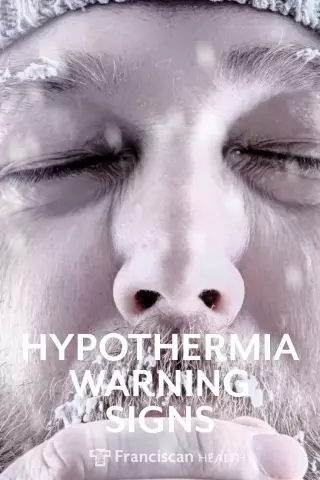- Author Rachel Wainwright [email protected].
- Public 2023-12-15 07:39.
- Last modified 2025-11-02 20:14.
Asphyxia
The content of the article:
- Causes
- Kinds
-
Signs
- Stage I
- Stage II
- III stage
- Stage IV
- Features of the course of asphyxia in newborns
- Diagnostics
- Treatment
- Prevention
- Consequences and complications
Asphyxia (suffocation) is a life-threatening condition caused by an excess of carbon dioxide (hypercapnia) and a lack of oxygen (hypoxia) in the blood and tissues. All types of asphyxia require immediate medical attention to the patient, and sometimes resuscitation measures, since the increasing hypoxia can lead to death within a few minutes. The problem of asphyxiation is relevant for many medical disciplines, in particular resuscitation, toxicology, traumatology, pulmonology, and neonatology.

Source: depositphotos.com
Causes
The development of asphyxia can be caused by:
- neck injuries;
- compression of the trachea;
- tongue sinking;
- ingress of foreign bodies into the tracheobronchial tree;
- aspiration of vomit;
- drowning;
- intraluminal tumors;
- ingestion of blood into the respiratory tract (with pulmonary hemorrhage);
- tracheobronchitis;
- angioneurotic edema;
- an attack of bronchial asthma;
- laryngospasm;
- tracheal burn;
- acute pneumonia;
- pulmonary embolism;
- pulmonary edema;
- atelectasis;
- total hemothorax or pneumothorax;
- massive exudative pleurisy.
Extrapulmonary factors can also cause asphyxia:
- overdose of tranquilizers, barbiturates, narcotic drugs;
- strokes;
- traumatic brain injury;
- intoxication.
Some infectious diseases cause paralysis of the respiratory muscles, leading to asphyxiation. These include:
- tetanus;
- polio;
- diphtheria;
- botulism.
Also, paralysis of the respiratory muscles can result in:
- myasthenia gravis;
- overdose of curariform drugs;
- spinal cord injury.
Poisoning with methemoglobin-forming agents (hydrocyanic acid and its salts), carbon monoxide, severe circulatory disorders, massive bleeding - all conditions accompanied by impaired oxygen delivery to organs and tissues also lead to asphyxia.
Asphyxia can also develop when inhaling air with a low oxygen content (for example, with altitude sickness).
In newborns, asphyxia can result from aspiration of amniotic fluid, intracranial birth trauma, fetoplacental insufficiency.

Asphyxia in newborns may be due to aspiration of amniotic fluid or birth trauma
The pathological mechanism for the development of asphyxia consists in oxygen starvation of all body tissues, the accumulation of under-oxidized products in them, which causes a shift in blood pH to the acidic side, that is, the development of metabolic acidosis. As a result, biochemical processes in cells are disrupted, the content of adenosine triphosphoric acid (ATP) in them decreases, cellular components undergo autolysis due to proteolytic processes; in other words, cell death occurs.
The most sensitive to asphyxiation are brain cells. Only a few minutes of severe hypoxia cause irreversible changes. Asphyxia quickly leads to myocardial damage, causing necrosis of muscle fibers. Edema and alveolar emphysema occur in the lungs.
Kinds
Based on the rate of development of hemodynamic disturbances and respiratory function, they speak of subacute and acute forms of asphyxia.
Depending on the mechanism of occurrence, asphyxia happens:
- Mechanical. Cessation or a sharp decrease in the flow of air into the airways is caused by their narrowing, obstruction or compression.
- Toxic. It occurs as a result of intoxication of the body with chemical compounds, leading to paralysis of the respiratory muscles, oppression of the respiratory center.
- Traumatic. The development of asphyxia is based on closed injuries of the chest organs.
Signs
In the clinical picture of asphyxia, several stages are distinguished:
Stage I
The lack of oxygen in the blood causes irritation of the respiratory center and a compensatory increase in its activity. The main symptoms are:
- inspiratory dyspnea (difficulty breathing);
- fright;
- excitation;
- cyanosis of the skin;
- increased blood pressure (BP);
- tachycardia.
If suffocation is caused by obstruction or compression of the airways, the face becomes purplish blue, becomes puffy. The patient seeks to get rid of the suffocating factor, wheezes, coughs.
Stage II
Depletion of compensatory reactions occurs, which has the following manifestations:
- the frequency of respiratory movements decreases;
- acrocyanosis develops;
- shortness of breath becomes expiratory (difficulty exhaling);
- the heart rate decreases;
- blood pressure decreases.
III stage
Pre-terminal state. The activity of the respiratory center fades away. Blood pressure drops sharply, breathing periodically stops (episodes of apnea), reflexes fade away. At the end of the third phase of asphyxia, loss of consciousness occurs, the patient falls into a coma.
Stage IV
Terminal state, which is characterized by the following manifestations:
- the skin is pale or cyanotic;
- agonal breathing;
- involuntary acts of urination, defecation, ejaculation;
- convulsive seizures.
The subacute course of asphyxia can last for several days. The patient takes a forced position: sitting, tilting the body forward and stretching the neck as much as possible. Noisy breathing, open mouth, tongue sticking out.
Features of the course of asphyxia in newborns
With asphyxiation of newborns, respiratory disorders quickly lead to hemodynamic disturbances, pathological changes in reflexes and muscle tone.
Assessment of the degree of asphyxia of newborns is carried out on the Apgar scale immediately after the birth of the child. The doctor assesses reflex excitability (heel reflex), muscle tone, skin color, respiration and heart rate in points (from 0 to 2). The severity of newborn asphyxia is determined by the number of points scored:
- easy (6-7 points);
- medium (4-5 points);
- severe (1-3 points);
- clinical death (0 points).
With mild asphyxiation, the newborn takes its first breath within the first 60 seconds after birth. Cyanosis of the nasolabial folds, decreased muscle tone are noted. On auscultation of the lungs, weakened breathing is heard.

All newborns are assessed on the Apgar scale for the degree of asphyxia
With moderate asphyxia in a newborn, the following are observed:
- irregular or decreased regular breathing;
- bradycardia;
- acrocyanosis;
- significantly reduced reflexes and muscle tone;
- weak cry;
- pulsation of the umbilical cord.
Severe asphyxia of newborns is manifested by:
- lack of breathing (apnea);
- severe bradycardia;
- areflexia;
- lack of screaming;
- lack of pulsation of the vessels of the umbilical cord;
- pallor of the skin;
- muscle atony;
- insufficiency of adrenal function.
Complication of asphyxia of newborns is the development in the first day of life of post-hypoxic syndrome, which is characterized by signs of impaired cerebrospinal fluid dynamics and blood supply to the brain.
Diagnostics
In acute asphyxia, the diagnosis is not difficult and is carried out on the basis of external signs and a physical examination. In case of pulmonary asphyxia, it may be necessary to consult an endoscopist, pulmonologist, narcologist, toxicologist, infectious disease specialist or neurologist.
Conducting an in-depth examination with asphyxia in most cases is impossible due to the rapid deterioration of the patient's condition and the growing threat to his life.
Treatment
Treatment of mechanical asphyxia begins with measures to restore airway patency:
- elimination of language sinking;
- weakening the loop squeezing the neck;
- removal of foreign bodies of the respiratory tract using bronchoscopy;
- tracheal aspiration of water, blood, accumulated mucus.
If the patient is in a state of clinical death, that is, there is no cardiac activity and spontaneous breathing, then after the restoration of airway patency, they immediately begin cardiopulmonary resuscitation.

Cardiopulmonary resuscitation for asphyxia
If indicated, tracheal intubation or tracheostomy is performed, after which the patient is connected to a ventilator.
The occurrence of ventricular fibrillation is the basis for electrical defibrillation.
In some cases, treatment of asphyxia begins with thoracocentesis. Bloodletting may be performed if venous pressure is high. Treatment of toxic forms of asphyxia is based on antidote therapy.
After the restoration of cardiac activity and respiration, correction of acid-base balance and water-electrolyte disorders, dehydration therapy (for the prevention of pulmonary or cerebral edema) are performed.

Electrical defibrillation for asphyxiation
If asphyxia is caused by an infectious disease or pathology of the nervous system, their active pathogenetic therapy is carried out.
Prevention
Prevention of asphyxia consists in the timely detection and treatment of diseases that can cause suffocation, prevention of chest injuries, and exclusion of contact with toxic substances.
Consequences and complications
The prognosis for asphyxiation is always serious. This condition is often complicated by:
- swelling of the brain;
- pulmonary edema;
- ventricular fibrillation;
- acute renal failure;
- the development of postresuscitation disease.
Acute asphyxia can result in death within 5-8 minutes. Patients who have experienced asphyxiation may develop aspiration pneumonia, and in the long-term period sometimes there are:
- decreased intelligence;
- lability of the psycho-emotional sphere;
- amnesia;
- paresis of the vocal cords.
YouTube video related to the article:

Elena Minkina Doctor anesthesiologist-resuscitator About the author
Education: graduated from the Tashkent State Medical Institute, specializing in general medicine in 1991. Repeatedly passed refresher courses.
Work experience: anesthesiologist-resuscitator of the city maternity complex, resuscitator of the hemodialysis department.
The information is generalized and provided for informational purposes only. At the first sign of illness, see your doctor. Self-medication is hazardous to health!






